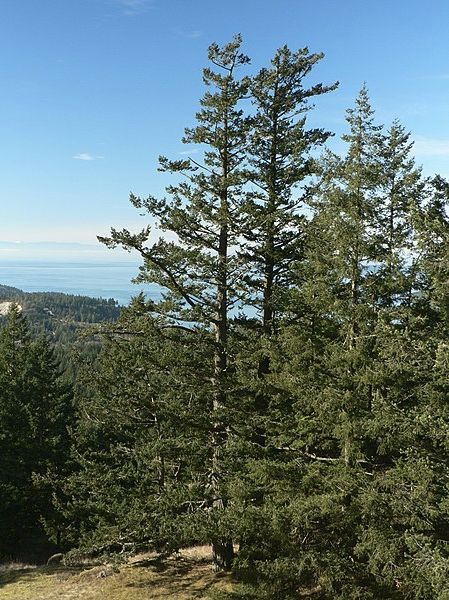By Charlotte Persons
Members of Black Hills Audubon Society already know the many benefits of trees, from stopping landslides and floods to reducing urban heat islands and filtering polluted air. Most urgently in our climate crisis, trees sequester carbon. However, developers clear trees on city lots to make way for new buildings, and timber companies harvest trees for timber and wood pulp. Which trees should be conserved? Here are three ways your voice can make a difference.
Updates to City Tree Codes
Cities across the Northwest, including Seattle, Tumwater, and Olympia, have directed staff to update tree regulations to help meet their climate mitigation goals.
Tumwater will be the second of the three contiguous cities in Thurston County to update its tree regulations. The process for the Vegetation and Tree Preservation Code revision began with the launch in October of an on-line open house. There you can find information about the codes, updates on the process, and opportunities for public input. Check out https://www.tumwatertreecity.com/
In about one year Olympia will begin updates to its tree regulations—after the Thurston County/City of Olympia complete a survey of the tree canopy.
In June, Lacey amended its tree removal permits to preserve more trees. Residents will now be allowed three tree removals in five years.
Friends of Trees, an action arm of the local nonprofit Restoring Earth Connections, hopes that the updates to tree regulations in Tumwater and Olympia will go further than Lacey’s amendment. One possibility is to institute an “exceptional tree program” like Seattle or Portland. Large trees, and sometimes mature trees in groves, can be nominated for preservation status.
For a full list of Restoring Earth Connections’ suggested changes for Tumwater’s code, go to their petition for Tumwater residents at https://docs.google.com/forms/d/e/1FAIpQLSdl-P4ZXvr-tiKMBp9opRLvQcnAicv-WYVA8-PIfQXouCpSoA/viewform
Preserve Legacy Forests
A number of environmental groups, including BHAS, are promoting the preservation of “legacy forests” in Oregon and Washington. Legacy forests are not as old as “old growth” forest—officially in Washington old growth forest has trees that began growing before 1850. Legacy forests are large stands of trees that were last logged before 1945. In that period logging companies left more young trees standing, did not clear the undergrowth, and planted no seedlings.
These second-growth forests have a mix of understory plants and trees of different heights that is closer to a “natural” forest ecology than today’s tree plantations. If left unharvested, the 80- to 130-year-old trees in these forests can become the old growth trees of the future. Meanwhile, these trees draw down and sequester more carbon than younger stands of trees and their forests provide habitat for a variety of wildlife.
In 2019 Board of Natural Resources’ approval of the Marbled Murrelet Habitat Conservation Plan released 38,000 acres of older trees for future logging. Recently DNR has proposed many timber sales for the next few years that will include legacy forests. Some are in Thurston County, including in the Capitol Forest and by Summit Lake; others are in Mason and Lewis Counties.
You may have read about the September 6, 2022, protest organized by Center for Responsible Forestry in front of the DNR building in Olympia and attended by Thurston County Commissioners Tye Menser and Carolina Mejia. Those commissioners also wrote letters to DNR about planned timber cuts. You can add your name to a petition to DNR to stop logging on legacy lands at https://www.c4rf.org/petition
To see the action plan for DNR endorsed by Black Hills Audubon Society, go to https://docs.google.com/document/d/1Ee9M6uxVWanPiEN_CapuTozcyEv3X1lZatlQVMf-KDA/edit
Choose Timber Parcels to be Conserved for Carbon Credits
In July a Washington Supreme Court decision re-enforced that DNR’s mission is to manage trust lands in state forests to benefit schools and local governments. However, the opinion also stated that DNR could raise funds “in a myriad of ways”, not just through logging.
In response the DNR began a Carbon Project. Eventually 10,000 acres of forests will be enrolled in the program. While 10,000 acres seems like a lot, it is 0.5% of the 200 million timbered acres that DNR manages. Businesses will pay for carbon offset credits at a price equal to what would have been paid for the timber. In phase 2 DNR is asking for public comment on over 11,000 acres of parcels. Based on those comments 7,500 acres of parcels will be chosen. You can comment on proposed timber parcels in Thurston, Mason, and Lewis counties by visiting https://www.dnr.wa.gov/carbonoutreach
Photo credit:Coast Douglas fir. Walter Sigmund. Wikipedia








